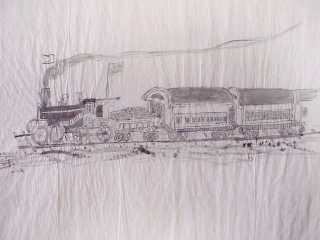| 小栗上野介の株式会社 交易で国民利福を考える Kozukenosuke Oguri's Joint-stock Company Considering National Welfare through Trade |
|---|
「日本最初の株式会社は坂本竜馬の海援隊と思っていたら、小栗上野介のほうがもっと早くに株式会社を作っていた。しかも定款や役員までそろっていた」と、経済学者の坂本藤良氏は語って東善寺で調査してゆかれ、好著『小栗上野介の生涯』(講談社・1987)を刊行された。 上野介が株式会社の組織を理解したのは、万延元年(一八六〇)、遣米使節として渡米の時だった。パナマでポウハタン号を降り、大西洋側へ出るために汽車に乗った。まだパナマ運河はなかった。 六年前の嘉永七年、ペリーが二度目の来航でお土産にした模型を横浜の海岸に敷いたレールで走らせたから、日本人は汽車の存在は知っていた。しかし、実際に乗るのは皆初めて。「速くて草木の見分けもつかない」「音がうるさくて、隣と話もできない」と驚いた様子が、従者の記録にある。 Economist Fujiyoshi Sakamoto conducted research at Tozenji Temple and said, "I thought Japan's first joint-stock company was Sakamoto Ryoma's Kaientai, but Kozukenosuke Oguri had established a joint-stock company much earlier. Moreover, he had the articles of incorporation and the board of directors in place," and later published his excellent book, "The Life of Kozukenosuke Oguri." Oguri first became familiar with the organization of a joint-stock company when he traveled to the United States as one of the Japanese envoys in 1860. They got off the USS Powhatan in Panama and took a train to go out to the Atlantic side. There was no Panama Canal yet the time yet. Six years earlier, in 1875, Matthew Calbraith Perry had given a model of a train as a souvenir on his second visit to Japan, and had run it on rails laid on the shore of Yokohama, so the Japanese were aware of the train's existence. However, it was the first time for them to actually ride on one. Followers of the Japanese envoys to the U.S. recorded their surprise: "It was so fast that I couldn't distinguish the plants and trees," and "The noise was so loud that I couldn't even talk to the person next to me." |
 パナマで乗った汽車は会社組織の経営だった。 (『小栗忠順従者の記録』より) The train we took in Panama was run by a joint-stock company. (From ""Records of a Follower of Tadamasa Oguri") |
この時上野介の関心は、速さや音よりも鉄道建設の経費とその調達方法にあった。「総費用七百万ドル、富裕の者から借り受けた出資金で建設し、利益から出資高に応じて年々割り戻してゆく」という説明を聞いた。日本人がコンパニー(株式会社)の組織を具体的に目にし、理解した場面である。 |
| 慶応三年、上野介は日本最初の株式会社「兵庫商社」を設立した。建議書にこうある。 「こんど、兵庫(神戸)を開港するについて、これまで長崎横浜を開いてやってきたが、西洋各国が港を開いて国の利益を得ているのに反し、日本は開港するたびに国の損になっている。これは商人組合のやり方をとらないで、薄元手の商人一人一人の損得で貿易を行ない…薄元手の商人が互いに競争で外国商人と取引するから元厚手の外国人に利権が取られてしまう。」 「これは商人一人の損失ばかりか、けっきょく国の損失になり、ついに全国の利権を失し、外国商人のために蔑視され、…」てしまう。だから「外国人と取引するには、外国交易の商社(西洋名コンパニー)のやり方に基かなくては、とても国の利益にはならない」。 そして、コンパニーの利潤をもってガス灯や書信館(ポストオフィシー・郵便局)、鉄道の設置をすれば、国にとっての莫大な利益になると提議する、画期的な上野介の構想であった。 At this time, Oguri was more interested in the cost of the railroad and how it would be financed than in its speed or sound. He heard the following explanation from the Americans: "The total cost of the project was $7 million, and it was to be built with capital borrowed from wealthy people, with the profits to be divided annually according to the amount of capital invested. This was the first time for Japanese people to see and understand the organization of a company (kabushiki kaisha, joint-stock company) in concrete terms. In Keio 3, Oguri established Japan's first joint stock company, Hyogo Shosha. The proposal for the establishment of a joint-stock company was as follows: "This time, we are going to open the port of Hyogo (Kobe). However, while Western countries have profited from having Japan open ports such as Nagasaki and Yokohama, Japan has lost money every time we have opened a port. This is because we do not follow the merchants' association approach, but rather trade on the basis of the profit and loss of each small-capitalized merchant. In other words, small merchants with little capital power compete with each other to trade with foreign merchants with large capital power, which leads to the foreigners taking their rights. "This is not only a loss for the merchant alone, but also for the nation as a whole, and finally the whole nation loses its rights, and is looked down upon because of the foreign merchant. Therefore, "it is not in the best interest of the nation to deal with foreigners unless it is done in the manner of a foreign trading company." Oguri's revolutionary idea was to use the profits from the company to establish gas lamps, post offices, and railroads, which he proposed would be of enormous benefit to the nation. |
 北斎の天井絵「鳳凰」で名高い岩松院の境内の頌徳碑には、小栗上野介の名も刻まれている。 The name of Kozukenosuke Oguri is inscribed on a monument of honor in the precincts of Ganshoin Temple, famous for Hokusai Katsushika's ceiling painting "Phoenix." |
|
しかし、明治維新によって兵庫商社は約半年の活動で解散し、鴻山の計画もむなしい夢と消えた。北信州で、上野介の構想に呼応して国の将来を考え、株式会社によって国民利福の道を開こうとした鴻山と上野介のつながりは、小布施町岩松院境内の頌徳碑に刻まれている。
However, with the Meiji Restoration, the Hyogo Shosha was dissolved after
only about six months of activity, and Tokai's plan disappeared as a vain
dream. The connection between Oguri and Takai, who thought about the future
of the country in response to Oguri's plan and tried to open the way for
national welfare through a joint-stock company, is inscribed on the monument
in the precincts of Ganshoin Temple in Obuse Town. |